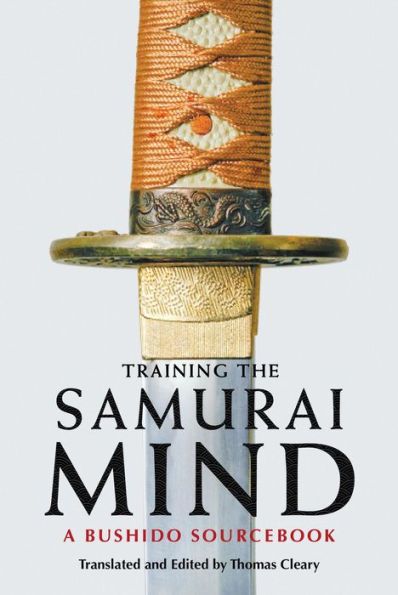

eBook
Related collections and offers
Overview
Through the ages, the samurai have been associated with honor, fearlessness, calm, decisive action, strategic thinking, and martial prowess. Their ethos is known as bushido, the Way of the Warrior-Knight.
Here, premier translator Thomas Cleary presents a rich collection of writings on bushido by warriors, scholars, political advisors, and educators from the fifteenth century through the nineteenth century that provide a comprehensive, historically rich view of samurai life and philosophy. Training the Samurai Mind gives an insider’s view of the samurai world: the moral and psychological development of the warrior, the ethical standards they were meant to uphold, their training in both martial arts and strategy, and the enormous role that the traditions of Shintoism, Buddhism, Confucianism, and Taoism had in influencing samurai ideals.
The writings deal with a broad range of subjects—from military strategy and political science, to personal discipline and character development. Cleary introduces each piece, putting it into historical context, and presents biographical information about the authors. This is an essential read for anyone interested in military history and samurai history, and for martial artists who want to understand strategy.

Product Details
| ISBN-13: | 9780834823082 |
|---|---|
| Publisher: | Shambhala |
| Publication date: | 10/06/2009 |
| Series: | Shambhala Publications |
| Sold by: | Penguin Random House Publisher Services |
| Format: | eBook |
| Pages: | 288 |
| File size: | 415 KB |
About the Author
Read an Excerpt
From Chapter Four: Suzuki Shosan (1579–1655)
Suzuki
Shosan was a reputed Zen master, a veteran warrior turned Buddhist
monk. As a samurai, he fought for Tokugawa Ieyasu in two campaigns, one
when he was only twenty-one, the second when he was already
thirty-five. Retiring from active military duty after Ieyasu had
succeeded in establishing the Tokugawa Shogunate in the early
seventeenth century, Suzuki later spearheaded yet another campaign,
this time on the cultural front, writing a polemic against Christianity
to bolster the Tokugawa ban on the religion, which was seen as a front
for European invasion of Japan. His popular preaching nonetheless
contains a great deal of supernatural threat and promise, unlike
mainstream Zen Buddhism.
In his instructions specifically
for samurai, Suzuki emphasized internal Zen psychology and focused on
using the professional requirements of the samurai life as a framework
for spiritual cultivation while also reinvesting spiritual development
in the perfection of performance in the line of duty. Accordingly,
whereas the importance of motivation by reward and punishment figures
prominently in typical military and political treatises, Suzuki Shosan
is one of the thinkers in bushido who explicitly disavowed the profit
motive in professional performance.
__________
Do your job with your mind as taut as an iron bow strung with wire. This is identical to Zen meditation.
__________
Use
your mind strongly even when you walk down the street, such that you
wouldn’t even blink if someone unexpectedly thrust a lance at your
nose. All warriors should employ such a state of mind all the time in
everyday life.
__________
There is a
practice designed to enter the Way of Buddha by means of your
profession. You should apply this idea, that a man born in a house of
valor, polishing a sword and sporting a bow, should always apply
attention strongly, as if he were marching right into an army of ten
million men.
The strongest men and the greatest masters of
martial arts are born that way, so no effort can attain that; but when
it comes to exerting our whole heart and disregarding our lives, to
whom should we be inferior? No one should think he’ll be beat, even by
the greatest warriors. Why? Because if you back down to such a person,
who will back down to you?
Thus you are always on duty, required to apply your full attention firmly. If you slack off, you’re no use.
Be
aware that this stable, firm attitude is itself meditation practice.
There is no other method of concentration to seek. Even Buddhism itself
is just a matter of applying full attention steadily, without being
disturbed by things. Developing a confident attitude that is never
pained or vexed or worried or saddened or altered or frightened is
called attaining buddhahood.
__________
There
are those who discuss the amount of rewards and size of entitlement of
men who have exercised considerable military valor, laid their lives on
the line, ground down their bones, and become famous. They are foolish!
Why not do a warrior’s deed, costly though it be, for the sake of
loyalty? People who think of rewards are nothing but military merchants.
__________
There
are myriad different methods of practice, but essentially they amount
to no more than overcoming thoughts of yourself. The source of
suffering is ego, the thought of self. To know this is reason. Knowing
the reason for suffering, what a sense of duty does is evoke effort to
extinguish the thought of self with a genuine courageous mind. People
without reason don’t understand the source of misery and happiness;
people without a sense of duty cannot break the bonds of life and death.
Table of Contents
Introduction 1
1. Shiba Yoshimasa (1349–1410) 172. Ichijo Kaneyoshi (1402–1481) 25
3. Nakae Toju (1608–1648) 31
4. Suzuki Shosan (1579–1655) 43
5. Kumazawa Banzan (1619–1691) 53
6. Yamaga Soko (1622–1685) 61
7. Kaibara Ekken (1630–1714) 69
8. Naganuma Muneyoshi (1635–1690) 79
9. Muro Naokiyo (1658–1734) 97
10. Yamamoto Tsunetomo (1659–1719) 109
11. Izawa Nagahide (active ca. 1711–1732) 113
12. Yamamoto Ujihide (n.d.) 121
13. Hakuin Ekaku (1686–1769) 127
14. Hojo Chikuho-shi (17th c.) 133
15. Takayama Kentei (fl. ca. 1761–1764) 141
16. Hayashi Shihei (1738–1793) 171
